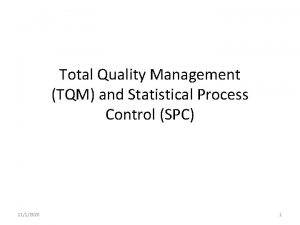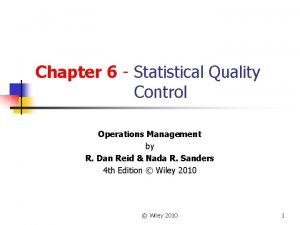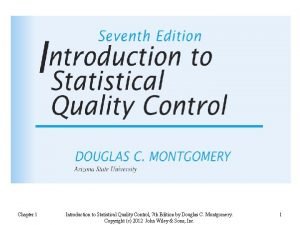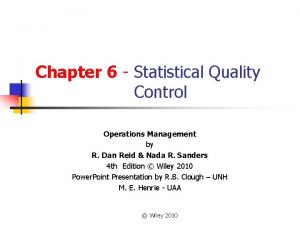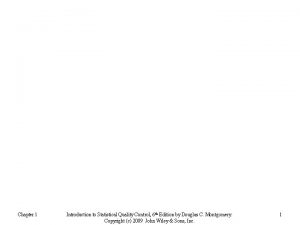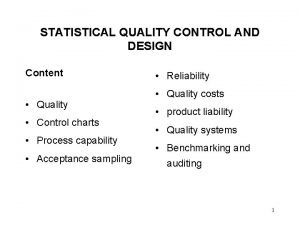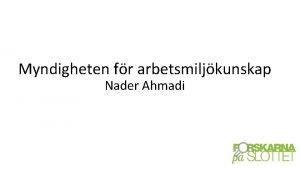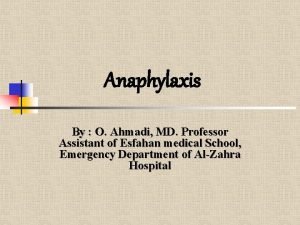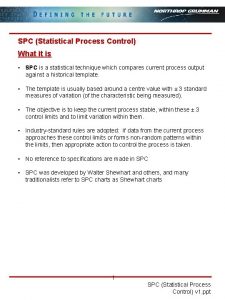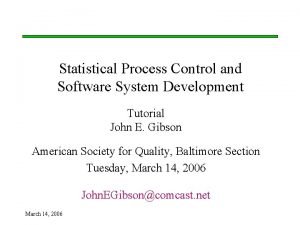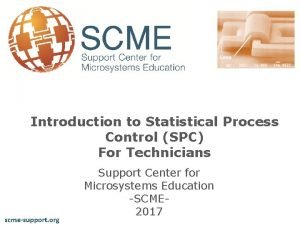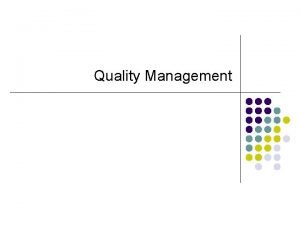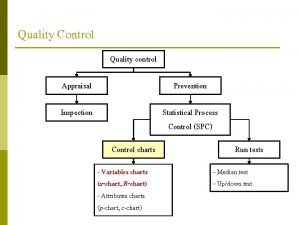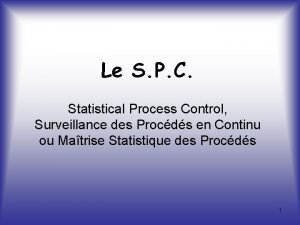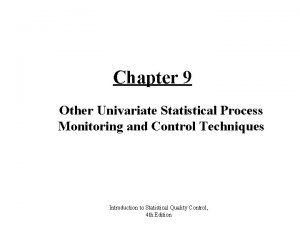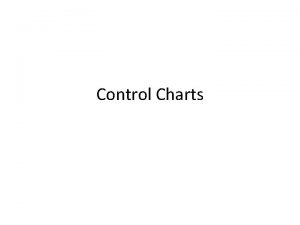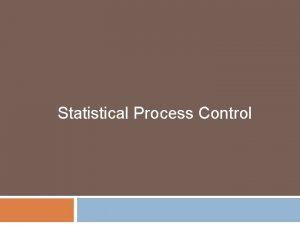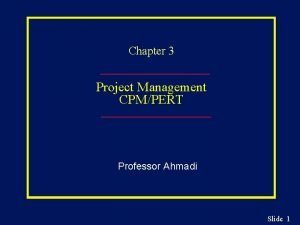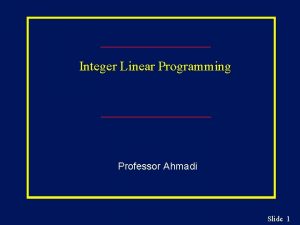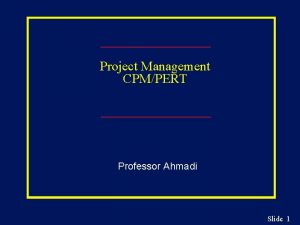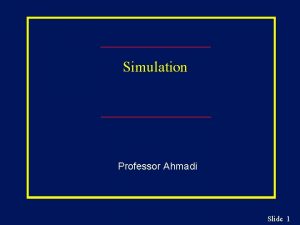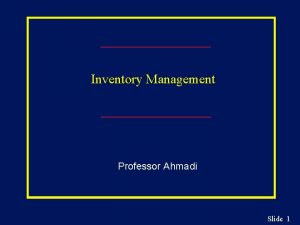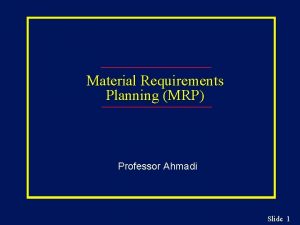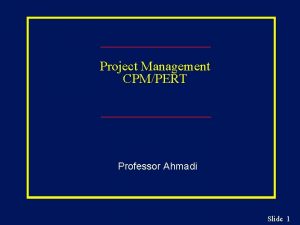Statistical Process Control Quality Control Professor Ahmadi Slide



















- Slides: 19

Statistical Process Control (Quality Control) Professor Ahmadi Slide 1

What is Quality? “The quality of a product or service is a customer’s perception of the degree to which the product or service meets his or her expectations. ” • • • Dimensions of Quality Determinants of Quality Costs of Quality Slide 2

Introduction n n Quality control (QC) includes the activities from the suppliers, through production, and to the customers. Incoming materials are examined to make sure they meet the appropriate specifications. The quality of partially completed products are analyzed to determine if production processes are functioning properly. Finished goods and services are studied to determine if they meet customer expectations. Slide 3

QC Throughout Production Systems n Inputs Conversion Outputs Raw Materials, Parts, and Supplies Production Processes Products and Services Control Charts and Acceptance Tests Quality of Inputs Quality of Partially Completed Products Quality of Outputs Slide 4

Quality Gurus n W. Edwards Deming • Assisted Japan in improving productivity and quality after World War II • In 1951 Japan established Deming Prize • US was slow in recognizing his contributions • Introduced Japanese companies to the Plan-Do-Check-Act (PDCA) cycle (developed by Shewart) • Developed 14 Points for managers n Joseph M. Juran • Played early role in teaching Japan about quality • Wrote Quality Control Handbook Slide 5

Quality Gurus (Continued) n Philip B. Crosby • Wrote Quality Is Free in 1979 • Company should have the goal of zero defects • Cost of poor quality is greatly underestimated n Armand V. Feigenbaum • Developed concept of total quality control (TQC) • Responsibility for quality must rest with the persons who do the work (quality at the source) Slide 6

ISO 9000 Standards n n Quality management guidelines developed by the International Organization for Standardization Companies become certified by applying to third-party providers who assess the level of conformity to the standards More than 300, 000 companies worldwide are ISO 9000 certified The US big three automakers have adopted a similar set of standards called QS-9000 Slide 7

Elements of TQM n n n n n Top management commitment and involvement Customer involvement Design products for quality Design production processes for quality Control production processes for quality Developing supplier partnerships Customer service, distribution, and installation Building teams of empowered employees Benchmarking and continuous improvement Slide 8

Statistical Process Control (SPC) n n n The goal of SPC is to determine whether the process can be continued or whether it should be adjusted to achieve a desired quality level. If the variation in the quality of the production output is due to assignable causes (operator error, worn-out tooling, bad raw material, . . . ) the process should be adjusted or corrected as soon as possible. If the variation in output is due to common (natural) causes (variation in materials, humidity, temperature, . ) which the manager cannot control, the process does not need to be adjusted. Slide 9

Decisions and State of the Process n Type I and Type II Errors State of Production Process H 0 True In Control Ha True Out of Control Continue Process Correct Decision Type II Error Adjust Process Type I Error Decision Adjust in-control process Allow out-of-control process to continue Correct Decision Slide 10

Definitions n n Type I error - Based on sample information, a good (quality) population is rejected Type II error - Based on sample information, a bad (quality) population is accepted Producer’s risk (a) - For a particular sampling plan, the probability that a Type I error will be committed Consumer’s risk (b) - For a particular sampling plan, the probability that a Type II error will be committed Slide 11

Control Charts n n n SPC uses graphical displays known as control charts to monitor a production process. Control charts provide a basis for deciding whether the variation in the output is due to common causes (in control) or assignable causes (out of control) Two important lines on a control chart are the upper control limit (UCL) and lower control limit (LCL) These lines are chosen so that when the process is in control, there will be a high probability that the sample finding will be between the two lines Values outside of the control limits provide strong evidence that the process is out of control. Slide 12

Types of Control Charts n n n An x chart is used if the quality of the output is measured in terms of a variable such as length, weight, temperature, and so on. x represents the mean value found in a sample of the output. An R chart is used to monitor the range of the measurements in the sample. A p chart is used to monitor the proportion defective in the sample. An C chart is used to monitor the number of defective items in the sample. Slide 13

Control Charts n n Primary purpose of control charts is to indicate at a glance when production processes might have changed sufficiently to affect product quality. If the indication is that product quality has deteriorated, or is likely to, then corrective is taken. If the indication is that product quality is better than expected, then it is important to find out why so that it can be maintained. Use of control charts is often referred to as statistical process control (SPC). Slide 14

Constructing Control Charts n n Vertical axis provides the scale for the sample information that is plotted on the chart. Horizontal axis is the time scale. Horizontal center line is ideally determined from observing the capability of the process. Two additional horizontal lines, the lower and upper control limits, typically are 3 standard deviations below and above, respectively, the center line. Slide 15

Central Limit Theorem n n The central limit theorem is: Sampling distributions can be assumed to be normally distributed even though the population (lot) distributions are not normal. The theorem allows use of the normal distribution to easily set limits for control charts and acceptance plans for both attributes and variables. Slide 16

Sampling Distributions n n n The sampling distribution can be assumed to be normally distributed unless sample size (n) is extremely small. The mean of the sampling distribution ( x ) is equal to the = population mean (m). The standard error of the sampling distribution (sx ) is smaller than the population standard deviation (s) by a factor of- 1/ Slide 17

3 s Control Chart Factors for Variables (Source: American Society of Testing Materials) Control Limit Factor Sample for Sample Mean Size n A 2 D 3 2 3 4 5 10 15 20 25 Over 25. 0015 n 1. 880 0 1. 023 0 0. 729 0 0. 577 0 0. 308 0. 223 0. 348 0. 180 0. 414 0. 153 0. 459 [0. 75(1/SQRT(n)] Control Limit Factor for Sample Range D 4 3. 267 2. 575 2. 282 2. 116 1. 777 1. 652 1. 586 1. 541 0. 45+. 001 n 1. 55 - Slide 18

Definitions n n n Acceptance plan - Sample size (n) and maximum number of defectives (c) that can be found in a sample to accept a lot Acceptable quality level (AQL) - If a lot has no more than AQL percent defectives, it is considered a good lot Lot tolerance percent defective (LTPD) - If a lot has greater than LTPD, it is considered a bad lot Slide 19
 Airline ticket
Airline ticket Heel toe polka steps
Heel toe polka steps Quality control operations management
Quality control operations management Introduction to statistical quality control montgomery
Introduction to statistical quality control montgomery Statistical quality control in operations management
Statistical quality control in operations management Introduction to statistical quality control
Introduction to statistical quality control Define statistical quality control
Define statistical quality control Nima ahmadi pour anari
Nima ahmadi pour anari Nader ahmadi
Nader ahmadi Princeton matlab
Princeton matlab Nooria ahmadi
Nooria ahmadi Promotion from assistant to associate professor
Promotion from assistant to associate professor Statistical process control ppt
Statistical process control ppt Statistical process control tutorial
Statistical process control tutorial Mssc introduction to spc
Mssc introduction to spc Statistical process control
Statistical process control 20 ของ300
20 ของ300 Controle spc
Controle spc Statistical process control
Statistical process control Quality assurance vs quality control
Quality assurance vs quality control
